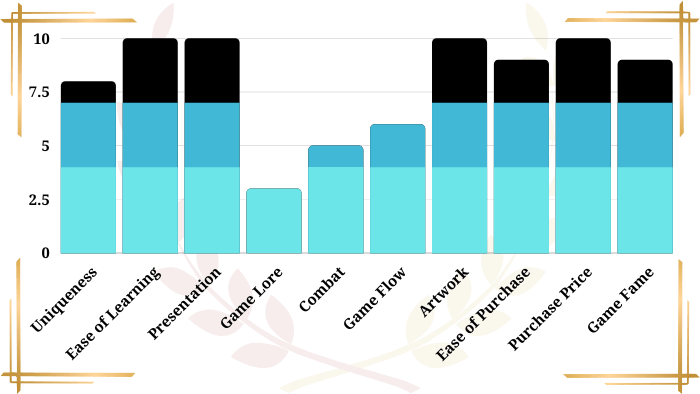Home > TTRPG Reviews
Savage Worlds vs D&D 5e
This article is part of my “Best Tabletop RPGs of All Time” article. If you want to check out more TTRPGs and see how other tabletop RPGs are ranked, visit that page. In effect, this article is a comparison of Savage Worlds vs D&D 5e (which ranks 1st on the list), as well as other top-tier games.
My Review – 80 / 100

Savage Worlds is one of the more unique TTRPGs out there as it aims to be playable in all genres: fantasy, sci-fi, mystery, modern, cyberpunk, etc. It has a large cult following, and despite being a relatively newer game (at least compared to DnD), has certainly earned its spot among top tabletop RPGs.
Uniqueness of Savage Worlds: (8/10)
Savage Worlds is in part so unique because it is a cross-genre game. The game is also a classless tabletop RPG, meaning that your character isn’t a knight, wizard, fighter, for example. Instead, you have an assortment of skills, attributes, and abilities unique to you. These various “powers” can be selected through ongoing character advancement.
I also like that players use a deck of cards for initiative in combat. The game features a Wild Die (also known in some games as an exploding dice – i.e. roll 6 on a 6-sided dice and you get to roll that dice again). Players can also gain “Bennies” for good roleplaying that let them re-roll dice, should they choose, under certain circumstances.
Ease of Learning Savage Worlds: (10/10)
It’s pretty easy to get started with Savage Worlds, and the game features pretty easy math (thank god). Your character has stats, skills, hindrances (limitations), and edges (bonuses). Select those 4 sets of character attributes and you’re ready to play. It’s refreshing to play games where characters can be built in under 30 minutes.
Your character’s hindrances and edges especially help define how you might roleplay them. Some hindrances and edges are designed for combat, but many are designed for smaller circumstances which still make for good roleplaying opportunities – things like “jack-of-all-trades” or “anemic.” Interesting character-defining stuff.
Savage Worlds Presentation: (10/10)
The overall presentation of Savage Worlds is very good, and the content is very clear. Referenceable tables are easy to use, and information is easy to find. There are good use of headers in the rulebook and colors to help players quickly find what they need.
This isn’t a huge point, but compared to many tabletop RPG core rulebooks, the Savage World book is exceedingly small – which I enjoy. For instance, other games in this top TTRPGs list have rulebooks over 500 pages. Meanwhile, the Savage Worlds PDF has only 163 pages, front and back cover included.
Eternity TTRPG Top Sellers
Lore of the Game: (3/10)
Because Savage Worlds is a cross-genre RPG, there’s not really any lore provided. The game does give you plenty of ideas to work with, however. So, I went back and forth on scoring this one a bit.
On the one hand, having lore for a game is always nice as it provides players with expectations for how the game “should be,” or “will be played.” On the other hand, having no lore provides players with a great deal of freedom as there are no built-in limitations.
What it comes down to, for me, is that if the game master in a Savage Worlds game is really dedicated to the game, good at their craft, and if they’re very clear on their concept of the RPG campaign world they’ve built, then having no built-in lore with Savage Worlds is fine. So long as players know what to expect going into the campaign, they can build characters that suit the game, and generally get more out of each gaming session.
However, most game masters don’t do a very good job of providing players clear expectations for their game world, prior to play. Instead, most organically develop campaign expectations over the course of many game sessions, which is typically how things should be.
One of the reasons that most tabletop RPGs provide lore is that it creates a game world that’s inherent and implied to the game, so there’s no need for game masters to detail their game world before a campaign begins. Established lore makes playing the game easier for the game master running the game.
If Savage Worlds did a better job of explaining this kind of concept in their core rulebook I think I’d give this score a higher rating. Since it doesn’t, however… I think the lack of lore is problematic even though there are other TTRPGs out there that also lack an established lore, which I’ve ranked higher in this category.
Combat in Savage Worlds: (5/10)
There are tons of rules in Savage Worlds which outline each specific situation that could arise (which is hard, since the game goes cross-genre). Many of these rules take appearance in the form of the various “powers” you can select for your character. That being said, you can really only “do” what your edges, powers, and sometimes hindrances, allow you.
You don’t get many edges and powers in Savage Worlds, even if you’ve played for a while. So, in my experience, combat comes with relatively few options.
Combat in Savage Worlds is ok. I mostly enjoy it. But I won’t say that it’s “great.” I wouldn’t love playing a massive fight or a dungeon with many battles as a gaming session in Savage Worlds, which is kind of a bummer since those are generally my favorite parts of tabletop RPGs.
Also, I’m not a big fan of classless RPGs like Savage Worlds – in general – because everyone ultimately ends up playing the same sort of character by the end of the game (one who can do everything worth doing). For example, if there are powers of flight, invulnerability, and huge damage attacks, every player will (eventually) get those abilities. Since there are no “class” restrictions, there’s nothing stopping everyone from becoming god-like in every aspect.
t’s a neat concept, but I have still yet to see a great classless RPG in a tabletop RPG format. This results in combat where each character – instead of having roles in the party (from their class) – basically just does a little of everything. I find many tabletop RPGs so much fun because class-based games provide so many specialties within the adventuring party.
Game “Flow”: (6/10)
It’s really simple to start playing Savage Worlds, which is wonderful. Resolutions in the game are also simple, when it comes to skill checks and combat.
The game is rules-light, which certainly helps with the game’s flow. You don’t need to reference a lot of things, so the story moves along quickly.
That beings said, the game almost feels like it doesn’t provide enough, to me, so without a skillful game master (as mentioned above), you’re really in a boat without sails.
If you have a great game master, Savage Worlds really does perform well. But the “game” itself really comes down to the skill and enthusiasm of the game master running it. For that reason, it’s not a game that anyone can pick up easily and really get into the flow and enjoyment of the game.
I’ve had very good Savage World experiences with great game masters. I’ve also had very bad Savage World experiences with new, inexperienced, and lackluster game masters.
All in all, I tend to favor games where new people can pick them up and play very easily. Though that’s certainly something Savage Worlds provides to players, as players, it’s not really something that it provides for game masters (and thus their gaming groups).
Savage Worlds Artwork: (10/10)
Savage Worlds does an amazing job of covering many genres in a single book. The art is high quality, fits the mood, and shows you all the types of genres in which you can play.
The art is also surprisingly consistent despite crossing genres, which is a big plus.
Ease of Purchase: (9/10)
Savage Worlds is easy to buy on the Pinnacle Entertainment Group site, or on Amazon. There are many supplemental books which can make purchase a little disorienting at first, but it’s quite easy to find what you need for the main game, and supplemental books for any genre in which you want to play.
I really like that Savage Worlds has continued releasing supplemental books over time that cover each genre of play in more depth (fantasy, sci-fi, mystery, modern, cyberpunk, etc.).
If you want to circumvent some of the problems with the game that I mentioned above (difficulty establishing clear expectations for game sessions and too few rules to support new game masters), purchase one of the Savage Worlds supplemental books that fits the genre you want to play. The supplemental books provide a lot of extra options for gaming, and clarifies the world in which your gaming group will be playing, for everyone at the table.
Price & How Many Books Do You Need to Play: (10/10)
Savage worlds has some of the best pricing of any tabletop RPG. There’s a very low cost of entry to game, of which I’m a huge fan.
The rulebooks are also pretty small compared to most tabletop RPGs, so even the printed books are very accessible in terms of price.
Fame & Availability of Supplemental Material: (9/10)
There all kinds of supplemental books for each genre in which you might want to play Savage Worlds. I consider these supplemental books vital for the type of genre you want to get into.
The main problem with the main game is that it’s a little thin/ small since it covers every conceivable genre out there. It hits everything, but in a mediocre sort of way. The Savage World supplements, in turn, flesh out those genres in much greater (and much more satisfying) detail.
In terms of finding other people to game with, many people play Savage Worlds and really enjoy the game, so you shouldn’t have much trouble. Just be sure to purchase the right supplemental book for your chosen Savage Worlds genre, and be sure to clearly communicate the game world with your group prior to play.
Savage Worlds is Produced By:













